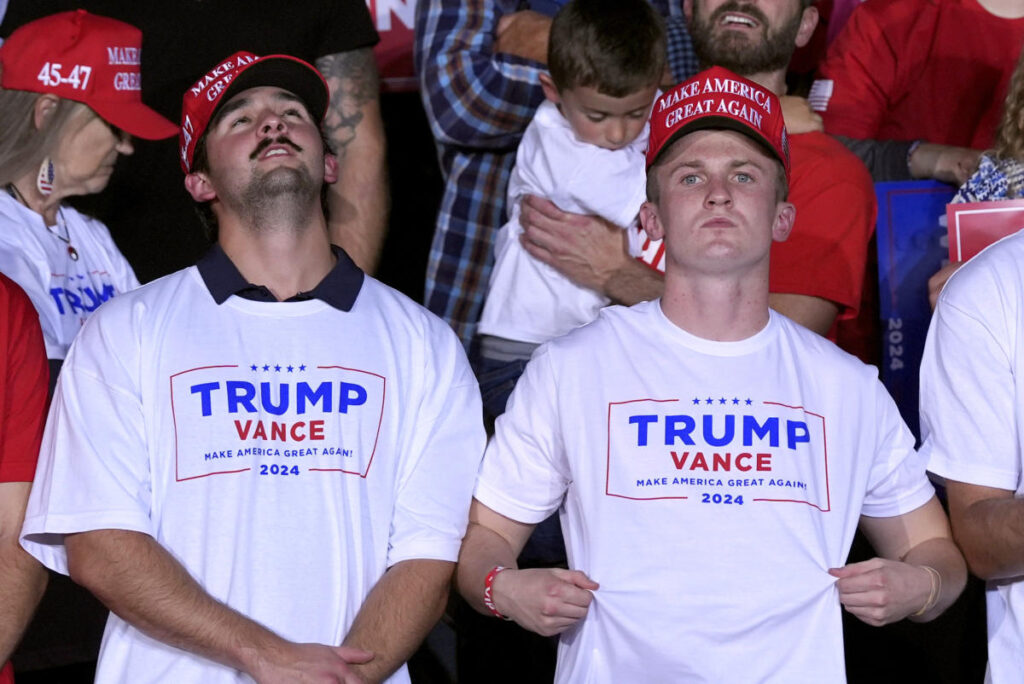In recent years, young voters, particularly males, have shown a significant shift in their political preferences, gravitating towards Donald Trump in the 2024 elections. This shift is illustrated by the story of Pat Verhaeghe, an 18-year-old first-time voter from suburban Detroit, who initially viewed Trump unfavorably but changed his perception after engaging with the former president’s campaign speeches and public appearances. Verhaeghe’s newfound admiration is echoed among many of his peers, illustrating a notable impact of nontraditional media and personal interactions on young voters’ opinions. With over half of men under 30 supporting Trump in the 2024 election, this demographic has shifted significantly right compared to their choices four years prior when many had backed Democrat Joe Biden.
Supporting data from AP VoteCast reveals that young white men solidly favored Trump, with approximately 60% casting their votes for him. Meanwhile, young Latino men showed a more divided stance, and while a majority of young Black men leaned towards Kamala Harris, about a third supported Trump. The decline in positive views of the Democratic Party among young Latino men is particularly notable, as their favorable opinion dropped from about 60% in 2020 to approximately 40% in 2024. In contrast, young Black men’s views on the Democratic Party remained largely unchanged, indicating different trends within these demographic groups.
A key factor driving the change in perception among young men toward Trump has been his ability to connect through alternative media platforms, such as podcasts, social media, and direct engagements. Rafael Struve, deputy communications director for Bienvenido, a conservative organization targeting young Hispanic voters, noted that young men are searching for recognition and representation rather than solely focusing on struggles. Trump’s support was bolstered by his appearances on popular platforms, including a lengthy segment on Joe Rogan’s podcast and a sports-related YouTube series, which allowed him to engage young audiences directly.
Trump’s popularity among young voters is not solely a personal phenomenon; it also reflects a broader rise in Republican identification among these groups. According to the data, there was a significant increase in young men identifying as Republicans in 2024, which William He, founder of Dream For America, described as alarming, suggesting a marked rightward shift in America. While young women leaned slightly toward Trump as well, their alignment with the former president didn’t mirror the intensity seen within the male demographic.
Democratic outreach efforts aimed at young voters, particularly through Kamala Harris’ campaign, faced challenges in effectively conveying their messages. Despite attempts to create policy agendas appealing to Black and Latino men and embracing popular culture, these efforts did not resonate as expected. Santiago Mayer, executive director of Voters of Tomorrow, criticized the Harris campaign for convoluted messaging and narrow policy targets, stating that many young voters simply didn’t connect with their economic proposals, which lacked a bold and straightforward vision.
The contrast between the Republican and Democratic approaches to youth engagement further highlights the current political landscape. Trump’s focus on pop culture, along with market penetration into youth online spaces, allowed him to maintain a connection with younger voters. Meanwhile, the Democrats struggled to keep pace, as traditional campaigning methods proved less effective in a rapidly evolving digital era. Striving to capitalize on the rising trend of young men leaning toward Republican ideals, organizations like Bienvenido intend to solidify this support for the future, acknowledging that sustaining this alignment will require continued engagement and fulfillment of their expectations in the aftermath of Trump’s presidency.

